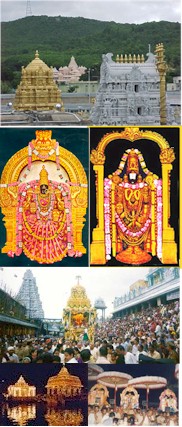Welcome to Adiyen Sri Ramanuja Dasan !
" Srimathe Ramanujaya Namaha !"
(22. Ans .: Contd...) The introduction of the kautuka bera was in a sense correcting an initial lapse. For, according to the Vaikhanasa Agama, complete worship in a shrine should necessarily involve the Dhruva bera associated with a Kautuka bera. Infact Kautuka bera is also called archa (the real idol for worship) and prana (the very life of all other idols). it is called Kautuka because it secures all welfare.
Bhrigu's Kriyadhikara suggests that the Dhruva bera is never properly worshipped, or formally, for it is absrtact and undefined. It is the Kautuka bera that it is suitable for worship by ordinary mortals who have desires to be fulfilled, the Dhruva bera is resorted to by sages who have no desires whatever, besides salvation. So, worship of Kautuka bera is superior, for it provides an effective base. The Archakas while in the worship has to invoke the power of the Dhruva bera in the Kautuka bera and worship the latter duly. It will benefit both the disinterested yogis as well as common folk.
The worship of Dhruva bera alone was described as 'niralamba' (without props), whereas the worship of Dhruva bera along with Kautuka bera is 'salamba' (with props). The former is possible only for the best of human beings whose capacity to visualize and concentrate is great but all ordinary people are eligible for the latter. The Kautuka bera is indispensable for generating devotion in the worshipper; and without devotion,whatever done is wasted. Therefore says the Agama, The Kautuka bera must be made and installed; by this, the prosperity of all the devotees is assured.
Devotion is generated not only by an idol consecrated but by elaborate worship rituals, and colorful festivals and food offerings. These latter were not there in the hill-shrine before Samavai instituted them. That she was prompted by the Vaikhanasa Priests to instal the kautuka bera becomes evident when we consider the restriction in the Agama texts that Kautuka bera must only be made of Silver. However a choice is given between silver, gold and wood, but silver is the first choice.
The upacharas that are offered to this day to this Kautuka bera like every day the first major sequence of worship is called 'Thomala Seva', because the main deity is decorated with flower-garlands. But, this sequence involves a ceremonial bath being given to the Kautuka bera and elaborate worship offered to it. It is only after this, that the gold coverings of the two feet of the main deity are removed and given a bath on a seperate seat.
In this sequence, the Kautuka bera plays an important role. The main deity in the sanctum is given a bath only once a week, on Friday. But daily worship includes the sequence of a ritual bath (Snaanaasana) or abhishekam, with water, raw milk, a paste of Chandan, Saffron and refined camphor. When the day's worship draws to a close, this idol is brought to Sayana Mantapam and put to bed.
A Swing cot (gold) hangs from the ceiling of the Sayana Mantapa by silver chains, and a soft mattress is prepared on it. The image is laid on this mattress in a recumbent position to the accompaniment of music and recitation of appropriate hymns. The Kautuka bera is given this serviceevery night of the year except for a month during the Dhanurmasam, when the image of Krishna is substituted.
In the Vaikhanasa Agama, the idol worship is likened to a fire ritual. Even as there are five forms of fire employed in a ritual, Sabhya, Ahavaniya, Anvaharya, Garhapatya and Avasathya. There are five forms of Vishnu involved in idol worship. These forms, when duly installed in a temple, will secure peace, nourishment and happiness for the devotees.
Jai Srimannaryana !
Thanks for your valuable time. Visit our web site again for more information and latest updates.

